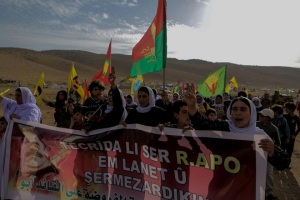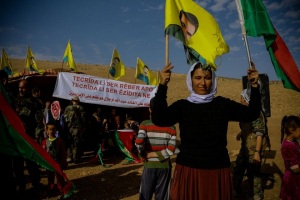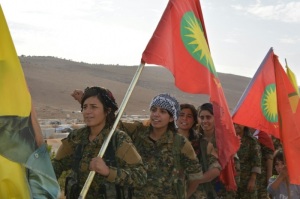 YJS commander Dersim Baran stated that they fulfilled their duty in Raqqa and that they handed over the rescued hostages to the SDF. With their camp based at Mount Shingal and at the Iraqi – Syrian boder, however, the YJS may not have much time to enjoy peace.
YJS commander Dersim Baran stated that they fulfilled their duty in Raqqa and that they handed over the rescued hostages to the SDF. With their camp based at Mount Shingal and at the Iraqi – Syrian boder, however, the YJS may not have much time to enjoy peace.
In September 2017 YAZDA released a report entitled “AN UNCERTAIN FUTURE FOR YAZIDIS: A REPORT MARKING THREE YEARS OF AN ONGOING GENOCIDE“. The report also stressed the potential for conflict with Yazidi being caught in the middle of conflicting interests stating:
The PMU (Popular Mobilization Units a.k.a. Hash al-Shaabi) is the second most influential force in Sinjar and the principal political presence in southern Sinjar. The PMU controls a swathe of land along the Iraq-Syria border and most of Nineveh Province. The two most prominent groups of the PMU in Sinjar are Kata’ib al-Imam Ali (the Imam Ali Battalions) and the Badar Organization. The PMU is said to be under the authority of Deputy Commander, Mahdi al Muhandis. Its presence has drawn further Turkish interests into Sinjar and created a potentially combustible situation with the PDK, as the latter reportedly perceives PMU as its ‘next generation’ enemy.
However, Yazidi are also aiming to assert themselves within the Hashd al-Shaabi. The report notes among others that:
The PMU in Sinjar comprises mostly Shi’a fighters from different brigades. However, a new Yazidi force is being established and is currently made up of approximately 2,000 Yazidi fighters under three organized battalions – Kocho, Lalish, and Ezidkhan. These are likely to increase in size in the coming months. A training base has been established in southern Sinjar to train Yazidi fighters in the battalions.
Two Yazidi commanders, Murad Shero and Naif Jaso, are the highest-ranking Yazidi leaders within the PMU. Other tribal leaders have also joined. Both the Yazidi Movement for Reform and Progress and the Yazidi Progress Party are supporting the CGI, the presence of the PMU forces and the Iraqi Military in Sinjar, but they oppose all Kurdish politics in Sinjar and all Yazidi areas. Some civil and independent groups as well as NGOs hold a similar position.
 The report also noted that the PMU, at least according to its public statements, appears to conform with Yazidi objectives for the population in Sinjar. It has promised Yezidi self-rule for their areas; the formation of a force under Yazidi leadership; and the bringing to justice of all those who participated in the genocide.
The report also noted that the PMU, at least according to its public statements, appears to conform with Yazidi objectives for the population in Sinjar. It has promised Yezidi self-rule for their areas; the formation of a force under Yazidi leadership; and the bringing to justice of all those who participated in the genocide.
However, now that the Central Government of Iraq, with the help of Iranian – backed Shiite Hashd al-Shaabi, has pushed Kurdish Peshmerga out of Shingal again, it remains to be seen whether the Hashd (and by implication Tehran) will honor their promises, if the Central Government in Baghdad will honor its promises, or if Baghdad reverts to is culture and policy of oppression.
Finally, there is a risk of Yazidi infighting as different armed Yezidi organizations have different affiliations, some of them being allied with the PKK and YPG, others with other Iraqi Kurdish parties and groups, and yet others again with the Hashd or the central government.
 The YJS is solidly anchored in its alliance with the Kurdistan Worker’s Party (PKK), putting it at odds with Turkey, Iran, the Shia-dominated government in Bagdad, the Syrian Baath Party government in Damascus, as well as those Yazidi militia that joined the Hashd al-Shaabi.
The YJS is solidly anchored in its alliance with the Kurdistan Worker’s Party (PKK), putting it at odds with Turkey, Iran, the Shia-dominated government in Bagdad, the Syrian Baath Party government in Damascus, as well as those Yazidi militia that joined the Hashd al-Shaabi.
Yazidi communities are, in other words, caught in the middle of regional and geopolitical rivalries involving the Central Government of Iraq, the Shiite government in Iraq, the uncompromisingly anti-Kurdish and increasingly Islamist Sunni Turkey, various – including rivaling – Kurdish groups from Iraq, Iran, Syria, and Turkey, an increasingly Iranian-dominated Syria, as well as the UK, other EU member States, the USA and Russia. The potential for a genocide and even an intra-Yazidi conflict is not only present; It constitutes an acute risk.
CH/L – nsnbc 23.10.2017
Source Article from https://nsnbc.me/2017/10/29/86890/
 RSS Feed
RSS Feed















 October 29th, 2017
October 29th, 2017  Awake Goy
Awake Goy  Posted in
Posted in  Tags:
Tags: 













